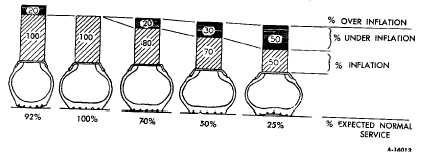|
| |
TRUCK SERVICE MANUAL
TM 5-4210-230-14&P-1
WHEELS, RIMS, TIRES
alignment. See "TORQUE CHART" for correct torque values.
After rim has been properly torqued, it should be
checked for alignment. This can be accomplished by rotating
wheel with a piece of chalk attached to a steady, firm surface
and placed to just barely clear outside surface of tire bead
seat. This procedure will point out the "high spot". Keep in
mind, however, that a "high spot" does not necessarily mean
that lug nuts have been unevenly tightened. This condition or
misalignment can also result from a bent wheel.
WHEEL AND TIRE BALANCING
Front wheel and tire assemblies must be balanced to
prevent wheel vibrating and bounce. While the correct front
wheel alignment is necessary for easy steering and maximum
tire life, the cause of unstable steering can be frequently
traced to improper balance of front wheels. When this
condition exists, the wheel assembly should be properly
balanced.
A vulcanized or retreaded tire, or a tire that has a boot
in it, may cause an unbalanced condition that cannot be
corrected by balancing. In such cases the tire should be
replaced before attempting to balance the assembly.
Static Balancing
A wheel out of balance statically has a tendency to
bounce up and down resulting in rapid tire wear in round or
oblong spots.
Static balancing is performed while wheel is stationary
by attaching weights to rim flange to offset an opposite heavy
point.
Static balancing may be sufficient in some instances
where vehicle is operated only at slow speeds, however,
dynamic balancing (in motion) balances the wheel and tire
assembly
statically
as
well
as
dynamically,
thereby
eliminating vibrations and wheel bounce at both low and high
speeds. NOTE: A wheel may be perfectly bal-
anced statically (not in motion) but may still vibrate and
bounce at high speed rotation because of its being out of
balance dynamically.
Dynamic Balancing
Dynamic balancing is complete wheel balancing of
which static balancing is only a part.
Dynamic balancing (in motion) takes into consideration
the distribution of weight to be added to the wheel. This is
accomplished by rapidly rotating (normal truck operating
speed) the wheel and tire assembly either on the vehicle or
with the wheel assembly removed and placed on a dynamic
balancing machine. This determines heavy point on wheel.
When the amount of weight required to offset a heavy
part in a wheel assembly is known, it is sometimes necessary
to attach one-half of the weight to the outside rim flange and
the remaining half to the inside rim flange.
With the weight properly distributed on the wheel
assembly, the wheel should be in balance both statically and
dynamically and should rotate free of vibration and bounce at
normal truck operating speeds.
TIRE CARE
Proper tire inflation, tire loads, and road speeds are
important determining factors governing tire mileage, and also
affect steering ease and maneuverability. How much these
three factors affect tire wear is illustrated in the paragraphs
which follow.
INFLATION
Tire pressures should be checked at regular and
frequent
intervals
and
the
pressures
maintained
to
specifications. Use an accurate tire pressure gauge and
check when tires are cool. The chart (Fig.. 10) illustrates the
loss in tire mileage caused by underinflation. It will be noted
that a tire underinflated only 20% will produce only 70%
normal mileage.
Fig. 10. Inflation vs. Mileage
CTS-2032N
Page 4
|

